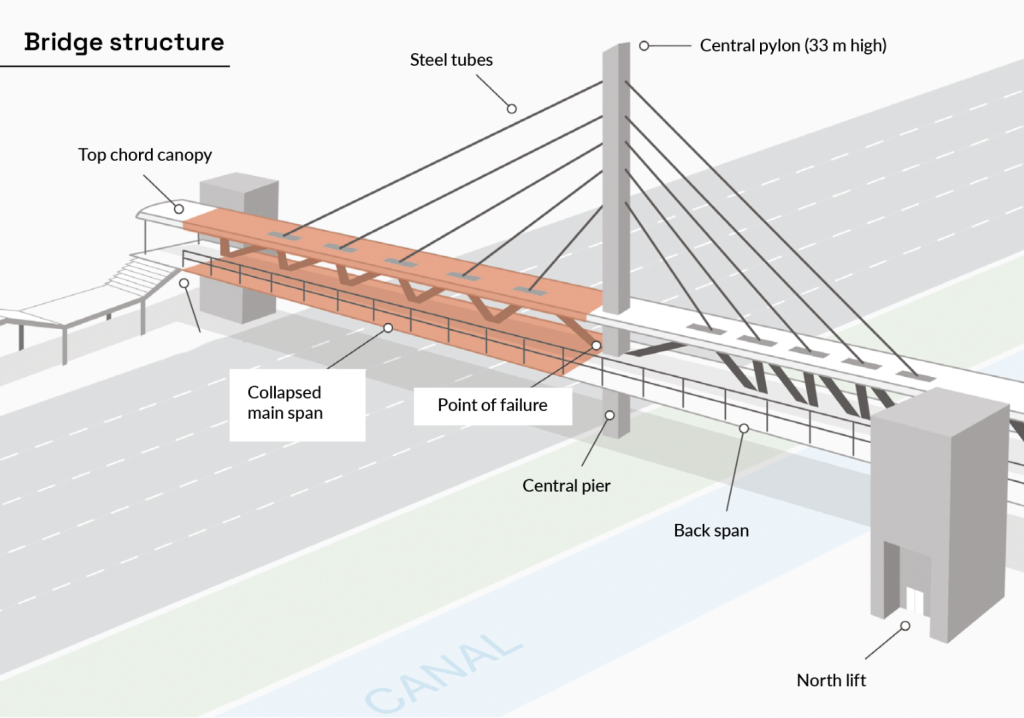The collapse of the bridge, which killed six people, was a clarion call for enhancing safety procedures in construction.
This article was originally published in the August 2024 issue of create with the headline “An avoidable disaster”.
On 15 March 2018, the 53 m-long main span of a pedestrian bridge at Florida International University collapsed, falling 5.6 m onto the road below in less than half a second.
Eight vehicles were crushed by the bridge, which was still under construction and not being used by pedestrians at the time. Six people were killed and 10 injured.
Flawed design
The simply supported bridge’s unusual design played a “massive” role in its eventual failure, according to Dr Sean Brady FIEAust CPEng, who spoke on the topic at a webinar hosted by Engineers Australia’s College of Leadership and Management.
“[It’s] incredibly rare to have a concrete truss bridge,” Brady said. “It’s certainly incredibly rare to have a bridge with only one line of truss members.
“This makes them [vulnerable]. If you break one of those members, the bridge is almost certainly going to collapse because there’s nowhere for the load to go.”
The node points where members met the canopy and deck were cold joints; the concrete of the canopy and deck had been cast separately to that of the members. This introduced an inherent weakness into the design, according to Brady.
This weakness was compounded when a design note to “roughen” the cold joint between the 11th and 12th members – left on the planning document for the contractors, with the aim of enhancing the interlocking between new and old concrete pours, and reducing sliding – was inadvertently omitted in the construction drawings.
The joint in question “snuck” through the peer review process, Brady said, and the flawed design ended up on site in a clear organisational failure.
A fatal structural error and misinterpretation of computer modelling contributed to the collapse of this Singaporean MRT station 20 years ago.
Failure to act
The main span was cast offsite and moved into position by a self-propelled modular transporter (SPMT), a 2020 safety alert by the Collaborative Reporting for Safer Structures UK (CROSS-UK) said.
“During lifting, the end diagonals cantilevered from the inboard SPMT supports in tension, so they were post-stressed to bring them back into compression during the temporary condition.
“When the main span rested onto the supports, the end diagonals returned to compression in the permanent condition, with the tension rods de-stressed.”
The bridge collapsed 19 days after the structure had been lifted into place. That morning, onsite engineers had conducted an inspection of the structure, identifying significant cracking at the node point between the 11th and 12th truss members.
Despite this, the road was not closed, nor the truss supported to reduce the load. Instead, the team elected to re-tension the bars in the distressed diagonal under compression, which added to the overall compression.
The main span collapsed during this re-tensioning operation. Following the failure of the node, the canopy and deck immediately fractured in separate locations, introducing a catastrophic flaw in the structure.
An investigation by the National Transportation Safety Board (NTSB) in 2019 identified “a complete lack of oversight by every single party that had responsibility to either identify the design errors or stop work and call for a safety stand-down, once it was clear that there was a massive internal failure”.
The NTSB concluded that:
- The design team “underestimated the demand … that would be acting on the nodal area”.
- The designers “overestimated the capacity of the node to resist shear (horizontal force) where the nodal region … was connected to the bridge deck”.
- Together, these mistakes “resulted in a node that lacked the capacity to resist the shear force pushing the node to the end of the bridge”.
Further to this, the CROSS-UK report found that “it is highly likely that the location of service voids, placed so close to the node which failed, was a contributory factor, as it appears this [was] not accounted for in the design”.
Aftermath
The event has become the subject of numerous studies. The collapse was described as an “avoidable tragedy” that should be carefully studied by organisations in the construction industry.
The recommendations outlined by CROSS-UK included:
- Cracks should be immediately addressed by an expert, especially if they appear without warning.
- Engineering decisions should be made by, or in direct consultation with, trained engineers.
- A project’s procurement strategy and contracts must be checked against the project’s complexity and the competence of its workers.
In addition, the NTSB stated that changes to bridge construction oversight procedures were necessary to emphasise “bridge and road closures [that] protect public safety when structural cracking (beyond what sound engineering judgment [sic] considers acceptable) occurs and to increase state oversight of complex bridge construction”.
Construction has begun on a replacement bridge, in the same location and with a more conventional design.
The collapse of the Francis Scott Key Bridge captured the world’s attention. A civil engineer explains what happened and what needs to change.
